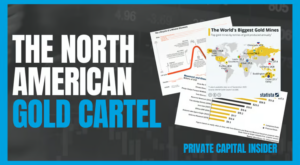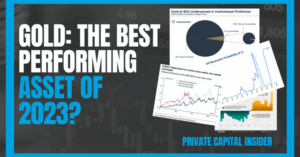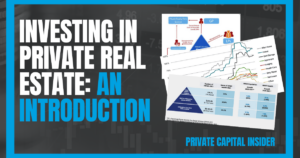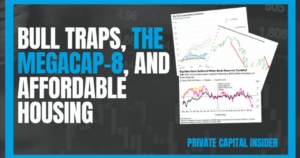Last week, we talked about how mathematically speaking, pretty much anyone can become a millionaire with enough time and effort.
But for anyone stuck in the “middle class millionaire” bracket – who are in the awkward position of being “rich, but not rich enough”…
Here’s a question I think a lot about: How do you turn a $1-5m portfolio into generational wealth that can take care of everyone you love?
As Naval Ravikant said in his famous Twitter thread:
“Seek wealth, not money or status. Wealth is having assets that earn while you sleep. Money is how we transfer time and wealth. Status is your place in the social hierarchy.”
So how do you seek wealth?
That’s the topic of today’s issue of Private Capital Insider.
Let’s dive in,
Jake Hoffberg
P.S. We appreciate that for many people, their life savings is not a game.
However, we choose to present our investor education as a game, because the purpose of games is to develop key skill sets you can use in the real world (and hopefully have fun along the way).
As a reminder, securities sold under Reg CF, Reg A, and Reg D are often considered high risk, and speculative in nature. Please do not invest funds you cannot afford to lose, or otherwise need immediate access to invested capital.
Why Savers are Losers When It Comes to Building Generational Wealth
If you’ve ever had a chance to do any retirement planning, chances are you’ve seen a chart that looks something like this.
Unless you woke up rich one day, chances are, you had a long period of time in the accumulation phase where you (hopefully) had decades of living below your means, building your savings, and making investments.
Then, one day – usually after the last kid has been shipped off to college – you enter the “Pre-Retirement” phase and start asking the question we all ask…
How many more years do I have to work until I can stop working for money?
For the first time in years, you finally get to think about yourself for once. And now, with probably a decade or so of good working years ahead of you, no matter how much you have saved, it’s probably not enough.
For most people, this “final decade” is the period where they earn the most income, have the highest savings rate, and wind up being the primary source of “risk capital” for entrepreneurial ventures.
But here’s the weird part about money: most people know they want more of it, but they also don’t really understand what money is or how it works.
Even though many of us grew up hearing the virtues of saving money…
In the Game of Money, savers are losers who get punished by inflation and missed opportunity costs.
You simply cannot save your way to wealth. Money must be converted into an asset that earns money while you sleep.
So if your goal is to increase cash flow and grow your net worth, the first thing you need to understand is what money is, and how Private Capital Insiders use money to build generational wealth.
A Brief Introduction to Money
In his 2011 book, Debt: The First 5000 Years, David Graber says there are three main functions of money: a medium of exchange; a unit of account; and a store of value.
Since Adam Smith’s time, economists have tended to emphasize money as a medium of exchange.
For Graeber, he says the best available evidence suggests the original monetary systems were debt-based, and that most subsequent systems have been too.
Pull out any denomination of USD if you don’t believe me. At the top, it says “Federal Reserve Note” with the notice that “this note is legal tender for all debts; public and private.”
What does this have to do with building wealth? A lot more than you think.
According to Wikipedia’s page on the Credit Theory of Money
Credit theories of money, also called debt theories of money, are monetary economic theories concerning the relationship between credit and money.
Proponents of these theories, such as Alfred Mitchell-Innes, sometimes emphasize that money and credit/debt are the same thing.
As Innes puts it in his 1914 article:
‘The Credit Theory is this: that a sale and purchase is the exchange of a commodity for credit.
From this main theory springs the sub-theory that the value of credit or money does not depend on the value of any metal or metals, but on the right which the creditor acquires to “payment,” that is to say, to satisfaction for the credit, and on the obligation of the debtor to “pay” his debt and conversely on the right of the debtor to release himself from his debt by the tender of an equivalent debt owed by the creditor, and the obligation of the creditor to accept this tender in satisfaction of his credit.’
Said another way, if you are exchanging a commodity for a credit/debt instrument – in this case, the US Dollar – this means commodities are the true source of all wealth.
And the real reason we as a society are wealthier today than we were 100 years ago is our ability to combine those commodities into more – and more valuable – goods and services.
So if your goal is to build generational wealth, it’s critical to understand that money isn’t wealth. It is a medium of exchange and unit of account (i.e. credits/debts).
But when used correctly, it’s a powerful tool for organizing groups of people to build productive enterprises (called Capital Formation) that can lead to the creation of wealth.
We can best see this represented in the Four Factors of Production: Land, Labor, Capital, and Entrepreneurship.
Together, the factors of production make up the total productivity potential of a given economy.
In turn, the final output of goods and services is referred to collectively as the Gross Domestic Product (GDP) and is used as a way to compare the productivity of a country as a whole.
Let’s take a look at each one.
Land: Land refers to all natural resources used in the production process. The income derived from the ownership or use of land is called rent (or sometimes “royalties”).
These resources are gifts of nature, and they include things like land itself, water, minerals, oil, and forests.
Labor: Labor refers to the human effort – both physical and mental – used in the creation of goods and services. The income earned by Labor is called wages, representing the largest source of income for most people.
Labor resources include the work done by the waiter who brings your meal at a local restaurant, the engineer who designed the car you drive, and contractor who built the home you live in.
Capital: Short for “Capital Goods,” Capital includes all man-made objects – like buildings, equipment, and chemicals – used in the production process. The income derived from the ownership of capital resources is interest.
In accounting, capital goods are treated as fixed assets. They’re also known as “plant, property, and equipment.”
A distinction is often made between physical capital and human capital.
Physical capital includes such things as machinery, buildings, and commodities.
Human capital includes the skills, abilities, and health of people.
Entrepreneurship: Entrepreneurship is the vision, skills, and risk-taking needed to create and run businesses. The income entrepreneurs earn is profit.
Entrepreneurs are a vital engine of economic growth. They are innovators and risk-takers who venture into new markets or create novel solutions, stimulating economic growth and development.
In addition, they bear the inherent risks and uncertainties of coordinating and managing these factors of production to build a business.
But here’s the interesting part about the Four Factors of Production: Did you notice that “Money” is nowhere to be found in this list?
There’s a good reason why it’s not.
Money – a medium of exchange and unit of account – has no utility.
It doesn’t become part of the product, nor does it transform or operate on the product in the way that Land, Labor, Capital, and Entrepreneurship do.
But in order to acquire Land, Labor, and Capital, the Entrepreneur still needs money to get the operation moving.
This is why you have an opportunity to participate in the potential profits of the enterprise as an investor.
How Insiders Turn Money Into Wealth
According to surveys conducted by The Spectrem Group, almost all affluent and wealthy investors acknowledge the importance of hard work, education, and smart investing when it comes to wealth creation.
For most people, hard work and education are the “easy” part of the equation. It’s the “smart investing” part that’s hard.
So what do wealthy people invest in to create and protect their wealth? Overwhelmingly, it’s in privately held businesses, real estate, and financial assets (like stock and bonds).
But there’s an obvious problem with looking at these charts about what wealthy people’s portfolios look like today when they’re wealthy…
How did these wealthy people acquire these assets in the first place? And which were the ones that made the biggest difference?
For basically the past century, there were only a few paths an average person could take to build significant wealth in a single lifetime.
According to generally accepted financial wisdom, the key is to spend less than you earn and invest the surplus into a diversified portfolio over a long period of time.
But here’s the problem with diversification. It might be a great way to stay rich and mitigate risk, but diversifying too soon will almost certainly prevent you from getting rich in the first place.
To understand why take a look at this chart. It shows the average height between a bush, a pear tree, and a redwood tree.
The Redwood Sequoia are the tallest trees in the world at more than 300 feet. If you look at most mature redwoods, they don’t have any branches on the tree for the first 100 feet up the trunk.
Compare that to a bush, which – at best – grows to 10-20 feet in height.
The difference? The redwood is hyper focused and concentrated on growth for as long as possible before it diversifies!
Accordingly, the oldest and tallest trees are generally the ones that wait the longest and grow the tallest before branching out, while those that branch out early are much shorter.
Conversely, the bush will never get very big because it diversified too soon.
This is a hugely important lesson when it comes to constructing a high-growth portfolio.
According to financial blogger Michael Kitces…
“In the world of investing, most people save and accumulate for retirement like a bush (or at least, that’s what we advise them as financial advisors).
Each bit of savings is allocated into a diversified portfolio, which like a bush with a lot of stems and branches, allows us to grow and bulk up over time.
After all, diligently saving “just” about $300/month in a diversified portfolio growing at 8% for 40 years is sufficient to grow a $1,000,000 portfolio (at least before taxes). Someone who is able to max out their entire $18,000/year 401(k) contribution for 40 years can accumulate a whopping $4.6 million in retirement savings.
However, as with the limitations of the bush itself, that’s about “as good as it gets” when saving for retirement like a bush.
And most people won’t even be this successful, as the average American doesn’t have enough “excess” income to max out 401(k) contributions, at least not every year for 40 years, when you also have to navigate getting married, buying a house, starting a family, child care, college funding, etc.
Not to mention that very few are able to earn enough to maximize their 401(k) contribution limit on top of even basic living expenses in the early career years.
You’ll likely never meet a Bush saver with more than $5M of net worth, unless he/she had an extraordinarily high income to save in the first place.
And you’ll certainly never find someone with $10M who achieved it as a Bush. To do that, you have to be a redwood.”
Or put another way, if you want to build substantial wealth… it requires a concentrated, focused strategy over a long period of time.
Even Warren Buffet famously stated,
“You know, we think diversification is—as practiced generally—makes very little sense for anyone that knows what they’re doing. Diversification is a protection against ignorance.”
Great advice if you’re the Oracle of Omaha, have a high degree of skill in valuing companies, and can negotiate directly with the company you want to make an investment in.
But you – a regular retail investor – are almost by definition likely to have less skill and substantially less experience than a professional investor.
So what options do regular investors have when seeking outside returns that can build significant wealth in the next 5-10 years?
And do it without taking extraordinary risks in pursuit of market beating goals?
We’ll talk about that in the next edition of Private Capital Insider.


